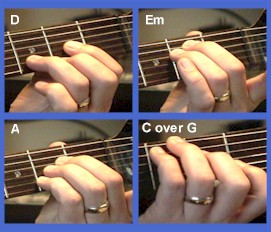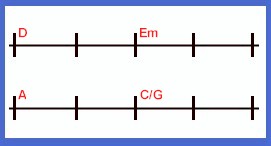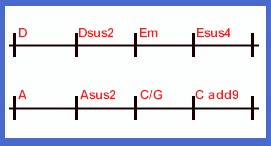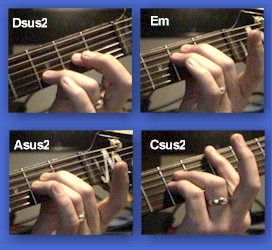Scroll through the lesson and click on notation/video/audio links to load the interactive players.
Please subscribe to get full access to all lessons for only $7.95/month PLUS 1 week free trial.

Riff Interactive lessons are
LESS expensive and
MORE interactive than alternatives!
More Info
|
|

In The Style of The Edge (U2) - part 2
Lesson Sample
Lyle: This lesson
is a continuation of part 1. During the first half of this lesson, I
wont be using effects, but in the second half I
will! Here's the jam track you need for the
lesson:
Looping
Sound Clip 1
Lyle: We are going to explore the rhythm style
of U2's - The Edge. The jam track is a simple 8 bar jam,
using 4 chords.
chord chart 1

Lyle: Here's the chords you'll need for this
first part of the lesson:
Lyle:
Some of these chords are easy and you might know them.
Lyle:
I'll show you other ways to play them in a bit. Here's how these 4 chords lay out in the
8 bar progression:
chord progression chart 1

Lyle: The Edge uses strong 8th note and 16th
note strumming patterns. Here's a couple video clips of this
technique:
8th
note strum pattern
16th note strum
pattern
Lyle: Notice that my right hand (strumming
hand) is the same motion for both the 8th note and 16th note strumming patterns
in the videos. On the 8th note pattern, you'll use all
down strokes. Just don't hit the strings on the way up. Try playing these chords and strum
patterns with the jam track.
Lyle: The Edge likes to use suspended
chords, like sus2, sus4. This means you take a regular chord
which is built from the root, 3rd and 5th,
and move the 3rd to the 2nd or 4th.
sus2 = root, 2, 5
sus4 = root, 4, 5
Lyle: Here's the next batch of chords I'd like
you to learn:
Lyle:
These sus chord offer a big sound.
Lyle:
This next chord is like a sus2 but it's called an "add9".
Lyle: Root, 3, 5, 9
Lyle:
Now you'll play the first 4 chords and insert these 4 chords like
this:
chord progression
chart 2

Lyle: As you can see in the chord chart, you
are filling in the open measures with these sus chord
variations. Here's a video of me playing this new
chord progression:
suspended chords
Lyle: Hear how the addition of the sus chords
bring this simple progression to life? There's more harmonic and melodic
movement.
Lyle: OK, time for the Edge
delay! This jam track is set for 125 beats per
minute (bpm). Edge likes to use what's called a dotted eighth note delay setting
so set your delay to 360 milliseconds (ms). The Edge sometimes mutes all the strings
creating a sharp, percussive sound. Watch this video of this
technique:
echo
example - muted string rhythm
Lyle: The delay effect is a part of the Edge's
style. The Edge also plays harmonics by gently
sliding his muting hand over the strings while strumming the
rhythm. This next video clip shows this
technique over the open D string:
echo example - open 4th string harmonics
Lyle: The Edge also plays open string
harmonics that create chords. Here's how to make a D chord at the 7th
fret:
Lyle: To make this harmonic, lightly touch the
string on top of the fret at the 7th fret and pluck. Here's a video of this
example:
echo
example - 7th fret harmonics
Lyle: Now I'd like to show you a couple more
examples of how to play this chord progression using the techniques from
above. First, here's a chord progression that's
just a little different:
chord chart 3

Lyle:
Using this chord example, with delay, here's a video showing a 16th note rhythm
pattern:
chord
progression 3 rhythm 1
Lyle: Next are two video
examples. Rhythm 2 uses the muted string technique, rhythm 3 uses the 7th and 12
fret harmonics:
chord progression 3 rhythm 2
chord progression 3
rhythm 3
Lyle: When playing simple chord progressions
in the style of The Edge, it's always good to know different places on the neck
to play the chords. Here's another look at this chord
progression way up the neck:
chord progression
4
Lyle: Before I go, I'd like to leave you
with....tonight's secret riff....
Lyle:
Hope you can see the use of these techniques that define the Edge's
style. Strong rhythms, sus chords and the use
of delay to fatten it up, along with different chord variations
that help give the song some dynamics.
Lyle:
That’s all for this lesson. If you would like further study on this topic or any
other topic, email me at Lyle@theguitar.net for info on how you can get your own
customized guitar lessons like this using Riff Interactive technology. Your
private lessons can be downloaded to your pc for anytime, anywhere study. Thanks
and see you at the next lesson. - Lyle
|
<< load notation from left
|
|
<< load audio from left
|
<< load audio from left
|